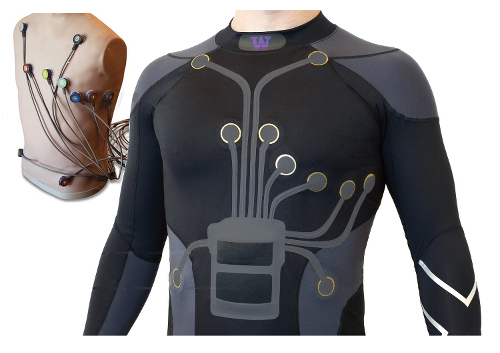Scientists are developing a low-cost smart textile sensor for early detection of tuberculosis in people and cattle which they hope will help tackle the spread of the disease in Asia and Africa. The Nottingham Trent University project – the first of its kind – aims to target the transmission of the disease in farms and farming communities in developing countries.
The researchers are creating a smart textile wearable sensor that would alert the wearer to early-stage TB when detected in their sweat, along with a separate sensor that would identify it in the saliva of cattle during the milking process.
TB is caused by bacteria that typically affects the lung and is a zoonotic disease, meaning it can be naturally transmitted from animals to humans. While human TB can be treated with antibiotics, this is not the case for cattle – and many countries have poor detection systems and healthcare.
In 2021 an estimated 10.6 million people fell ill with TB worldwide and 1.6 million died from the disease, making it the second leading infectious killer after COVID-19.
In 2014 it was estimated that there were 9.6 million cases of TB worldwide with 1.5 million deaths – and Asia and Africa occupied 86% of all cases.
TB symptoms in people can look mild and it can take weeks from the initial infection before someone feels unwell – in some cases, known as latent TB, the infection does not cause any symptoms, allowing it to spread even more easily.
The Nottingham researchers aim to develop a cheap, biodegradable, and non-invasive device that would have a tiny fabric strip sensor – about 0.1 mm thick – which would react with TB bacteria and give a reading of TB, latent TB, or nothing.
The technology would help to reduce transmission among people in communities and enable intervention through the early segregation of infected cattle, minimising the risk of endangering and potentially slaughtering other animals.
Information from the sensing system would also be used to control the environment on the farm, such as providing disinfectant footpaths between farm buildings, clean housing and equipment, and helping to avoid the sharing of equipment between farms.
TB can be transmitted through direct contact with infected domestic and wild animals, or indirectly through environmental contamination or by consuming raw milk dairy products or meat.
In many developed countries the preferred approach to managing TB in infected animals is to ‘test and slaughter’, whereby if one or more animal tests positive they are slaughtered along with any others in the herd thought to be at high risk.
This is not practical in some heavily infected countries, however, as it could necessitate slaughtering a large number of cattle, which may not be feasible due to human resource or financial limitations, or cultural reasons.
Human TB is often confirmed via patients’ sputum – or phlegm – but its sensitivity is low and other challenges mean that there can be a delay in diagnosing the disease. Other detection methods and techniques are not routinely used in developing countries due to their cost or complexity.
A skin test is the standard method for detecting animal TB but takes 72 hours to reveal the results – and as well as being expensive, blood-based tests can take up to eight weeks.
The project combines expertise and infrastructure from NTU’s School of Science and Technology, School of Animal Rural and Environmental Sciences and Medical Technologies Innovation Facility.
“TB remains a leading cause of disease and mortality in developing countries – in low-middle income countries about seven percent of all deaths are attributed to it,” said researcher Dr Yang Wei, an expert in electronic textiles and electronic engineering in Nottingham Trent University’s School of Science and Technology
The researchers hope that the same platform could be used for other diseases commonly found in human and animals.




